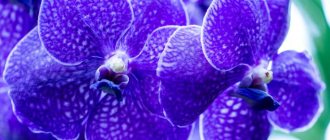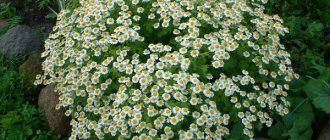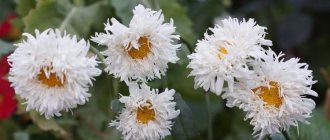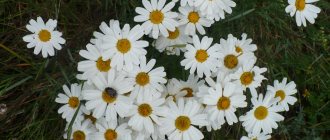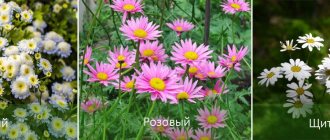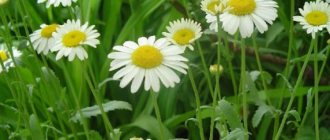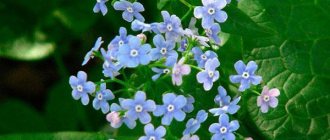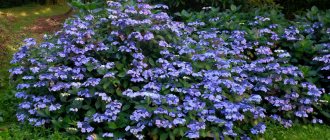Even the most indifferent person will not pass by a flower called blue daisy. The unusual, picturesque view and pleasant, fragrant aroma attract attention and sink into the soul for a long time. Gardeners are happy to plant this flower in their plots, which harmonizes well with other plantings and decorates the landscape design with its original colors.
Blue chamomile. Appearance
What do these flowers look like?
Chamomiles and most similar plants belong to the Asteraceae family. Its representatives are easily identified by :
- herbaceous stem;
- elongated shape of the petals;
- a basket framed with petals;
- weak aroma.
The most common type of chamomile is chamomile . Large or decorative ones are most often found in flower beds. Asters, some varieties of chrysanthemums and gatsanias also have large inflorescences.
Multi-colored daisies
The first sign by which you can distinguish them is the color of the petals. In chamomile or decorative chamomile they are white. There are similar flowers with different shades of petals .
Blue
The blue color indicates that Asters or Cineraria have grown . The latter's petals are sometimes colored half white, which creates a pleasant decorative effect.
Colored
Colored daisies, which have petals in different colors and shades, are called Anemone Blend or Anemone Corona . Echinacea varieties also have similar colors.
Yellow
Doronicum (kozulnik) is most often confused with yellow ones . You can also find Pyrethrum with lemon-colored petals, this variety is very similar to Chrysanthemum due to its double petals and small shrub shape.
Purple and lilac
Asters, Osteospermum with purple petals look very beautiful in borders and bouquets . This also includes lilac daisies; the brightness and type of shades vary depending on the variety of a particular plant species.
Reviews from gardeners
_qi_
They grew it in the garden...out of two packets of seeds and some sprouts, three survived to be planted in the ground...one of them took root in the ground. Summer survived, blooming more or less.
Source: www.e1.ru
roseland
As they write about it, it is quite unpretentious. But I have little sun because of the forest and many things are not available to me.
Source: www.websad.ru
Common flowers similar to daisy
Despite the similarity, each flower is unique. They differ not only in appearance, but also in life expectancy , susceptibility to disease, unique medicinal or simply useful properties. What are these flowers called and what do they look like?
Anacyclus
Anacyclus or anacilus is a perennial plant with creeping stems and large flowers. It is used to decorate alpine slides, as it is low (up to 5 cm) . The buds are dark pink, but the petals are white inside.
Helichrysum daisy flower
Helichrysum daisy flower is a perennial plant in the form of a low (up to 10 cm) and wide bush (up to 50 cm) . The leaves and stems are gray, the petals are densely packed together, white.
Doronicum
Doronicum or kosulnik is a perennial plant with bright yellow petals and core, grows from 0.3 to 1 m in height . The leaves are triangular and deep green.
Nivyanyk
Nivyanik is a perennial plant that forms a bush 0.3-0.8 m high . The blooms are large, with dense oblong white petals, the core is bright yellow. There is only one corolla on one stem, unlike chamomile.
Calendula
Calendula or marigold is an annual herbaceous plant 0.5-0.6 m high . petals are orange or deep yellow. The leaves are green in the form of an elongated oval.
Daisy
Daisy is a perennial plant most often found in ornamental crops. The flowers are full, the petals are colored pink, white, lilac, the core is soft yellow. A neat bush grows up to 20 cm tall . The leaves are oblong, located at the base of the stem.
Pyrethrum
Pyrethrum or Dolmatian, Persian chamomile is a perennial herbaceous plant 0.4-0.6 m high . The flowers are large, but there are varieties with small and full corollas. The color of the petals varies from white to burgundy.
Arctotis
Arctotis is an annual or perennial plant 0.20-0.3 m high. On a bare stem there are inflorescences with a diameter of 5-10 cm, depending on the variety . The color of the petals is white or pale yellow. The dark green leaves have a light silvery coating.
Gatsania
Gazania or gazania (African chamomile) is a perennial or annual plant. It grows up to 30 cm in height, the inflorescence is 5-9 cm in diameter . The color of the petals varies, but red and pink varieties are popular. The leaves are dark green, curly.
Gerbera
Gerbera is a perennial plant. Bare stems 0.4-0.6 cm high, hard . A rosette with long petals (up to 0.35 m) and dense, with a diameter of 0.05-0.15 m. Gerberas come in any color, with the exception of blue.
Venidium
Venidium grows up to 0.8 m. The petals are elongated with pointed ends, the rosette is not stuffed. Venidium comes in pink, white, orange and yellow . The heartwood is brown or burgundy.
Read also Is it possible to replant geraniums in the fall in October
Cosmea
Cosmea is an annual or perennial 50-150 cm high. The stems are tender, the leaves are thin, reminiscent in shape of chamomile or dill . The petals are long, painted in one or two colors (edge effect), and are white, red, pink or purple. The inflorescence is up to 12 cm in diameter.
Coreopsis
Coreopsis is a perennial or annual plant. The height of the bush is 0.5-0.9 m, the leaves are thin . Flowers are rich shades of yellow; there are specimens with burgundy petal bases.
Osteospermum
Osteospermum is a perennial plant, but cultivated varieties are grown as annuals. It grows as a bush 0.25-1 m high, inflorescence diameter 4-10 cm . The color of the petals is white, various shades of red, purple.
Sunflower
Decorative sunflowers differ significantly from their counterparts. Depending on the variety they are :
- Miniature.
- With double and dense blooms.
- Multi-colored.
Some of them, especially the tuberous sunflower, look like a giant yellow daisy. Such plants grow up to 3 m in height , and the inflorescences are 3-5 cm in diameter.
Jerusalem artichoke
Jerusalem artichoke or earthen pear is a perennial plant with stems 0.50-4.0 m high. Flowers are yellow, their diameter is up to 10 cm .
Ursinia
Ursinia is an annual or perennial 30-60 cm high. The flowers are bright yellow, white or purple, glossy, up to 5-6 cm in diameter . Ursinia leaves are dark green in color.
Chrysanthemum
Chrysanthemum is a perennial with many flowers . The most common is the Korean chrysanthemum with thin, rigid stems, openwork light green leaves and flowers 2-5 cm in diameter. Chrysanthemum petals can be of a wide variety of shades and colors: from white to purple.
Echinacea
Echinacea is a perennial with medicinal properties . On stems with leaves there is one flower with a core protruding upward. The petals are pink or purple, oblong with pointed ends.
Erigeron
Erigeron is a perennial that grows up to 40 cm in height . Petals are elongated, rounded, color: white, pink, yellow, violet, purple. The inflorescence is 2-5 cm in diameter.
Varieties of felicia
It is believed that felicia has two large species, which have both common and distinctive features.
- Berger or Felicia the Tender.This is a very popular type of felicia, which is valued for its extreme compactness, since the average height of the plant does not exceed 20 cm, so border growing is ideal. Despite its compactness in height, this does not in any way affect its spreading ability, because on average the figure is twice as large. The foliage is modest in size and attractive in color - a mixture of rich greens and a bluish bloom. The inflorescences are blue, 3-4 cm in diameter. Inside each flower you can see a yellow center. Anyone can plant this type of felicia, since planting occurs using the classic seed method. You can enjoy the beauty of blue inflorescences as early as July.
- Felicia Amelliformes. According to botanical characteristics, felicia is a perennial plant, although the actual information is different. In our region, this and other types of felicia are considered annuals. The plant is not too small, since the height can reach half a meter, and even more, which is an achievement for Felicia. The foliage has a familiar color, where green and bluish shades are mixed into one tone. Each leaf has distinct fibers. The inflorescences are very reminiscent of a chamomile, as there is a yellow center inside, and there are many petals in a circle. The only nuance is the color, because blue, with a hint of turquoise, is a real feature of Felicia amelliformes.
How to choose a flower that looks like a daisy?
Among the listed variety, every daisy lover will find a suitable option. The choice depends on the properties of the varieties, preferences in colors and plant size. Chamomile-like flowers come in different colors, heights and even types (grass, shrubs) . They are selected for any ensemble in a flowerbed and they will last for many years, delighting with bright colors and long-lasting flowering.
Blue daisies are a decoration for any garden. Few flower growers know the correct name of the flower and how to care for it; you can learn about all this below.
Growing on site
There are several ways to grow garden chamomile. Which method to choose depends on what time of year the planting takes place.
Seedling growing method
- a depression of up to 30 cm is made in the ground;
- Fertilizer is placed in the hole: compost or organomineral mixture;
- There is no need to remove old soil from the roots to avoid damage;
- The soil must be irrigated after planting.
Flowering should begin next year, but much depends on the characteristics of the variety.
Dividing the bush
It is better to plant by dividing the bush in the first half of autumn once every 2-3 years. Planting a flower is necessary for more spectacular flowering, which fades as the bush grows.
- the rhizome is divided into parts with several growth points;
- the seat should be slightly larger in size than the rhizome of the plant being planted;
- It is advisable to pre-fertilize the hole and straighten the root;
- After planting, the soil is compacted and watered.
Flowering occurs the following year.
If chamomile is grown for cutting and to form bouquets, the most suitable growing method is division.
Growing from seeds
Tips for growing large chamomile with seeds:
- To collect seeds, you need to wait until the flower stalks ripen (the petals should dry out and the baskets should turn brown).
- Cut and dry the inflorescences.
- Dry the seeds and remove debris from them.
- It is recommended to store seeds in a paper bag with an air hole.
Sowing period is autumn and spring.
Sow chamomile as follows:
- seeds are sown to a depth of no more than 2 cm;
- distance between rows – 20 cm;
- It is recommended to mulch the beds.
It is not recommended to make a flower garden in a shady place. Spring sowing will produce seedlings by autumn that can be transplanted.
Brief description of the culture
Blue chamomile is a plant of South African origin. Gardeners often forget the correct name of this crop - felicia. This flower belongs to the Asteraceae (Asteraceae) family. In its homeland, blue chamomile perennial grows in the wild; in Russia, this South African plant is cultivated as an annual.
Important! Suitable for rocky gardens, borders, and for planting along paths.
Blue garden chamomile looks great in flower beds with yellow flowers. Its inflorescences are used to prepare cosmetics. The essential oils included in the composition have a beneficial effect on the skin of the face.
Types of beautiful daisies
Gardeners often grow these low-maintenance plants on their plots. Below in the article we will list several varieties of chamomile that will be a wonderful decoration for any flower bed, as well as a brief description of them.
Chamomile without tongue is a herbaceous, annual plant with a pronounced fragrant aroma, for which it began to be called fragrant. This chamomile does not have white petals, unlike other daisies. The core of these flowers, the inflorescence, has a rich yellowish-green color and a more convex structure.
Another distinctive feature is a lot of thin string-like leaves, densely sitting on a thick stem, which gives the flower a denser and fluffy appearance. These flowers cannot tolerate shade and love open sunny space, which is why they are often found on roadsides, wastelands, abandoned and crumbling areas, which are characterized by a complete absence of trees and weak vegetation cover. In the garden, the pleasant greenery of the annual will highlight the brightness of other flowers.
Important! Fragrant chamomile is used as an antiseptic, analgesic and sedative in folk medicine, which is recommended to be used with caution, as there are contraindications.
Blue perennial daisy, or amelliform Felicia, is native to South Africa, where it grows wild. In Russia it is bred by gardeners. The unusual coloring of the petals for chamomile, from soft turquoise to rich blue shades, sometimes with purple veins, goes well in a flower bed with yellow flowers.
This small plant, up to half a meter tall, has small leaves that are hardly noticeable under large inflorescences 5 cm in diameter. Blue chamomile grows in abundant and long-flowering bushes. Blue Felicia needs regular moderate watering and feeding at least once every three weeks.
Planting and care
Chamomile is best propagated by seeds. It is allowed to sow them in open ground, but it is also possible for seedlings.
To obtain seedlings, seeds are planted in March. Before this, they need to be kept in the refrigerator for about 3 weeks. Planting in open ground begins in mid-May. To do this, prepare holes in the soil and sow 3 seeds there. The holes are made at a distance of 30 cm. Shoots will appear in 14 days if the temperature is about 20°C, and flowering will begin in 6 weeks.
Important! The area for this crop should be sunny, fertile with light soil. On a summer afternoon, it is advisable to shade the plant.
Further care for this flower consists of regular watering. Dry soil is a sure sign that the plant needs moisture. During drought, watering is increased. Chamomile planted in containers should be irrigated regularly.
Read also Lingzhi mushroom: how to brew plates and drink
Dry stems and flowers need to be torn off. Summer residents recommend pinching the plant to stimulate the appearance of new flowers.
Important! A special feature of this plant is that cloudy weather will not allow the flowers to open; they will be closed until the sun appears.
Chamomile needs feeding once every 3 weeks. Complex formulations for ornamental crops are suitable for fertilizer. Thanks to them, the flower will be resistant to the first frosts, this will not affect its flowering. But it is important to remember that too fertile soil can stimulate the growth of green mass to the detriment of flowers.
For your information! Many gardeners grow blue chamomile as a houseplant, which they take outside in the summer.
Propagate by seeds and cuttings
| Method No. 1. Seeds Stages:
| |
| Method No. 2. Cuttings Stages:
|
Diseases and pests
Among the diseases, it is worth highlighting powdery mildew. Among the pests that love this chamomile are aphids and spider mites. They can be controlled with fungicides and insecticides.
Felicia is a beautiful plant that even a novice gardener can grow. You just need to put in a minimum of effort!
He loves, he doesn’t love, he will spit, he will kiss, he will press him to the heart, he will tell him to go to hell...
Botanical name of the plant: Matricaria recutita (synonyms: Matricaria chamomilla, Chamomilla recutita, Rauschert, Chamomilla chamomilla (L.) Rydb.), Family: Asteraceae (Asteraceae, Compositae).
One day you will have a dream, It will touch you with yellow paint, And a white petal will envelop your face with dawn, tender caress... The flower from the dream and the dream calling to the flower are beautiful...
Blue chamomile (small petal or erigeron) occupies a special place in the space of the plant spirit. In a unique way, she is both obvious and mysterious. This plant has about two hundred white, pink, purple, blue, yellow petal shades.
Conventionally, it could be argued that German chamomile is the most powerful, but everything, of course, depends on the plant’s growing zone, and then chamomile (wild chamomile, chamomilla officinalis, chamomilla stripped, Hungarian chamomile) can be compared in strength to blue chamomile, for the latter is characterized by a special inner strength, its spirit, and not its color.
In Rus', the name of a given flower was determined by its properties and behavior, so it was called either a storyteller, or a belyusha, a morgun or a ruddy, and sometimes also a Roman grass.
The origin of another name for this plant, Komola, is interesting. This is a word meaning “closed in oneself, unable to tolerate duplicity and deception.” Associated with this is a special procedure for collecting the plant, for which the herbalist specially prepared himself. The most important principle of preparation was silence for three days in order to achieve a stable emotional state.
Blue daisy is, in principle, not so much a definition of the type of plant as a designation of its fundamental difference from all other daisies. Blue chamomile is a chamomile that has power. This is a plant to be venerated.
Although chamomile is a plant that grows almost everywhere, its distinctiveness is expressed as strength, or even more correctly, insight, for which the regenerative restoration process associated with chamazulene (C14H16) is responsible. Actually, the chamazulene concentrate when processing the flower determines blue chamomile as blue.
Chamazulene is a carrier of many beneficial biological properties. It is the main exponent of blue chamomile activity. It not only enriches, but ferments the plant, improving it and at the same time becoming a source of active substance. This substance improves the connective tissue of the plant. This occurs due to chamomile breathing, which can be called chamazulen breathing.
This is a type of breathing that is characterized by a certain effort to assimilate carbon dioxide. And plants such as blue yarrow and blue chamomile occupy a special place on our planet, forming within themselves a blue-violet, deeply saturated compound called chamazulene. Thus, depending on the manifested properties of breathing, chamomile can become either a simple chamomile or a chamomile that has mastered chamazulent breathing.
This etheric compound has special characteristics: it is the code of the space in which the blue chamomile ripens. German chamomile, blue chamomile (Matricaria recutita) and Roman chamomile (Anthemis nobilis) are species of daisies capable of expressing different chemotypes, the best of which is produced by the chamomile known as blue (α-bisabolol oxide B > α-bisabolol oxide A > α-bisabolol).
A chemotype is a uterine secretion of a plant capable of converting and producing an additional source of energy. This discharge has a fruity odor, more reminiscent of an apple. With its help, various priestly communities (in particular, the Celtic Druids) communicated with trees. Thus, from ancient times chamomile was considered a shamanic plant or a plant of sorcerers. It represents the energy of the sun on Earth and is considered a knowing, knowing plant.
Chamomile is a symbolic flower. It not only acts as a symbol of rebirth and everything new, but is also capable of pointing the way in the direction of the beautiful and joyful, while simultaneously hiding many secrets about our lives.
Read also How to soften a sheepskin sheepskin coat
If the plant is full of energy, it can be communicated with, although Blue Chamomile crystalline essential oil is a good option here. It is difficult to find a more calibrated, insightful partner than this flower from a geometry standpoint. And in general, we can say that chamomile most vividly personifies the entire Aster family, numbering thousands of species.
Thus, this, perhaps the most popular flower in the world, not only since ancient times expresses the symbolism of various natural feelings, but in general is a symbol of all flowers, occupying a special place in the plant world and representing one of the highest forms of life in nature, producing an energetically active biological compound , the like of which few are able to generate at all. This is evidence of the real unique capabilities of the forces of nature.
Blue daisy is a ceremonial flower, in different circumstances it plays different roles for contact with the forces of nature. And, of course, this is a very romantic, sunny flower, carrying both lightness and mystery.
Necessary favorable conditions
A site for planting is selected in accordance with the requirements of the culture. Not every location and soil is suitable for the plant.
Characteristics of the site for blue daisy:
- fertile soil with low acidity;
- sunny, well-ventilated land;
- absence of drafts;
- looseness and porosity of the soil;
- low groundwater level;
- moist soil.
Despite the fact that the site is chosen on the sunny side, on a hot summer afternoon the flower is shaded.
Love does not love
The flower has become especially popular due to the fortune-telling practice, during which the fortuneteller pulls out chamomile petals one by one with the question “loves or does not love” until the last petal remains, which will become the answer to the question. Despite all the apparent simplicity and naivety, this fortune telling also has a serious cosmic meaning: a blue chamomile accumulates the essence of the moon at night, and the sun during the day. Thus, the flower reproduces and gives people the aromas of love, so it is not difficult for it to answer the question “loves or does not love.” Chamomile is the keeper of knowledge about love and its aroma.
Loves - doesn't love - loves... The flower knows the whole truth And answers for everything with its head: Loves - doesn't love - loves...
Where chamomile grows, nature comes to life, feeding on the forces of love of this flower, its tenderness. In reality, of course, true fortune telling can only be done on the flower in which the necessary chemotypes mature, capable of actively interacting with the starry sky and storing this energy within themselves.
Low-growing border perennials that bloom all summer
Among the most attractive border perennials that bloom throughout the season is the Snegurka variety. What does this chamomile look like? It is a double flower of traditional colors, although its appearance is more reminiscent of a chrysanthemum than of representatives of the daisy family. The bushes are quite large, the height can reach a meter. Each stem ends in a boiling-white inflorescence, the diameter of which reaches 10-12 cm. The center is decorated with a bright sun. The flower is heat-loving and does not tolerate shady areas and closed spaces. If the amount of sunlight is not enough for the Snow Maiden, she will begin to wither, the flowers will become small and lose their fullness.
Maiden chamomile is also popular among gardeners - fluffy green bushes dotted with small snow-white flowers. The plant is unpretentious, grows quickly, and therefore is often considered a weed.
For your information! Maiden chamomile is one of the most beloved plants in nunneries. And it’s not just about its delicate and discreet beauty, it has a large number of useful properties.
By the way, in the Middle Ages these flowers were called mother herb (Parthenos in Latin), which definitely indicates the healing properties of the plant. With the help of decoctions of dried herbs, women could get rid of pain during menstruation and ease childbirth.
Flower growers note that maiden chamomile is not at all afraid of drought and temperature changes, but excessive humidity, especially after the snow cover has melted, can negatively affect the root system. That is why, with the onset of spring, it is recommended to remove all snow from the flowerbed where it grows.
Blue chamomile flower
Blue chamomile is an annual plant reaching 60 centimeters in height. Usually its shoots are densely branched, and they are abundantly dotted with a large number of small flowers.
The flower can easily be confused with certain types of asters, daisies or gerberas. The main difference is that chamomile has equal length, longer and narrower bracts and pointed ray leaves. Flower baskets are multi-rowed, long-pointed, abundantly pubescent. The outer petals of the flower are usually bent, they are slightly shorter than the inner ones. The petals are bluish, lilac or violet; when dried, they curl into a tube.
Hemispherical baskets of chamomile inflorescences (4–20 mm in diameter) are located singly at the ends of the shoots, forming individual corymbose inflorescences. Flower baskets have a characteristic pleasant smell and bitter taste. They contain up to 0.85–1% essential oil, which contains more than 40 useful substances.
In the European part of Russia and in the south, chamomile can bloom very early - in March-April. Since flowering occurs unevenly, flowers can appear all spring, summer and even in autumn, until the beginning of November. At the same time, the plant is undemanding and frost-resistant. Thanks to this, and also due to the great love for open spaces, sun and sunlight, chamomile grows well not only in warm regions, but also in cold climate zones (in the Arctic, North America, Siberia) - in the tundra, on dry hillsides, along sandy river banks, on mountain rocky cliffs and slopes.
The place where chamomile grows determines not only the characteristics of its growth and development, but also the pollination process. Usually the plant is pollinated by wasps, less often by bees.
The chamomile fruit is a small oblong achene with four to five thin brownish-green ribs on the inside. The fruits are very small (length 1–2 mm, width 0.2–0.3 mm). Twenty thousand fruits weigh only 1 gram.
How to plant a large garden chamomile in the garden?
Preparing the soil and choosing a planting site:
- Before planting the plants, the soil is fertilized (compost - at least 1 bucket per 1 square meter, mineral fertilizers).
- For planting large garden crops, it is preferable to choose slightly acidic soils; otherwise, dolomite flour or slaked soda is added.
- The bushes need space, since garden chamomile can grow without changing place for 3-5 years;
- The landing site should be sunny.
- Under no circumstances should you choose a wetland - this will lead to the occurrence of diseases.
When and how to plant?
- Sowing of seeds takes place at the end of May - end of July.
- To grow seedlings, seeds are sown in March in specially prepared pots with drainage (or ordinary plastic cups, but we must not forget to make a hole from the bottom).
- Planting by dividing the rhizome is carried out in September - early October.
- Seedlings are planted in May.
When is the best time to replant garden chamomile?
It is recommended to replant in the autumn, in the first half, after flowering, when there is young growth. Replanting is also possible at the end of spring, when there is no longer frost.
Planting a plant: two alternative methods
Cultivated relatively recently, cornflower has not forgotten the skills of independent seed propagation. It is recommended to sow in the spring, at the end of May, when the threat of the return of cold weather has completely passed. The seeds are scattered thickly over the surface of the site and lightly sprinkled with fertile soil. In the northern regions, you can cover the area with seeds with agrofibre.
Nielberry seedlings are thinned out at the age of three pairs of true leaves. This is done because the small seeds of the plant are difficult to separate from each other. To combat thickening, leave 2-3 plants at each point, with up to 40 cm of distance between them. Watering is done with caution.
Plant chamomile seeds in open ground
You can start growing garden chamomile from seedlings. As in the first case, the seeds are almost not planted, and the seedlings are subsequently planted in individual containers. Before the emergence of shoots, the future cornflower plantation is kept under film or glass, and later it is generously sprayed with a spray bottle. Nielberry seedlings are transferred to open ground at the end of May.
Attention! The popovka root system cannot withstand stagnant water, which necessitates a good drainage layer in pots with seedlings.
Interesting Facts
- According to the modern dream book, if you dream of large chamomile flowers , a joyful event will happen soon, and weaving a wreath of daisies means happiness with your loved one.
- Large garden chamomile is a real find for florists : it does not fade in a bouquet for up to 10 days.
- Chamomile is a symbol of light, purity and fidelity , so it is no coincidence that it was chosen as the subject of fortune telling; For these purposes, since ancient times, the largest inflorescences have been selected, which established the plant as the most valued by lovers.
- Garden chamomile, like medicinal chamomile, easily relieves inflammation , has an antibacterial and sedative effect, and is also used to prepare teas and decoctions.
vote
Article rating
Nivyanik or popovnik
It is the cornflower that is most often called chamomile, but it is a separate genus of the Asteraceae family. Nivyanik or popovnik is a herbaceous perennial plant up to 70 cm high. The stem is straight, almost does not branch. Basal rosette of simple leaves.
The plant is unpretentious, caring for it is not difficult and is accessible even to a novice gardener.
Breeders have created many interesting varieties of cornflower:
- Maxima Kenig;
- May Queen;
- Alaska;
- Vethoven
- Nivyanik Luna;
- Winner;
- Bridal veil;
- Fiona Coghill.
Nivyanyk
Differences between Nielberry and Chamomile
Why are nivaria and chamomile often confused? Let's compare these plants.
| Sign | Nivyanyk | Chamomile |
| Basket size | up to 12 cm | up to 6 cm |
| Sheet | Dense, hard, solid, with a jagged edge. | Cirrus dissected |
| Stem | Single, carries one basket | Branched, bears many inflorescences |
| Smell | Light "chamomile" aroma | Without smell |
Nivyanik is used in solitary, mixed plantings in flower beds and along walls.
How to grow more crops?
Any gardener and summer resident is pleased to receive a large harvest with large fruits. Unfortunately, it is not always possible to obtain the desired result.
Plants often lack nutrition and useful minerals
It has the following properties:
- Allows you to increase yield by 50%
in just a few weeks of use. - You can get a good harvest even on low-fertility soils
and in unfavorable climatic conditions - Absolutely safe
Fertilizer and fertilizing for bright flowering
When growing garden chamomile, it is impossible to do without fertilizer, because it needs nutrition to bloom a huge inflorescence. The larger the variety and the more active it is in flowering, the more nutrients it needs.
Water the chamomile as the soil dries out
Phosphorus-potassium fertilizer is applied in the fall when preparing the flower garden for future plantings. In the future, nitrogen fertilizing is carried out:
- in the spring after the snow cover has completely melted;
- at the beginning of budding;
- in the middle of July.
Suitable sources of nitrogen include ammonium nitrate, urea, mullein diluted in water, or bird droppings.
Attention! Chicken manure is a fertilizer that is oversaturated with nitrogenous substances and can burn chamomile roots. Dilute it in a ratio of 1:15 and apply only to moist soil.
Felicia amellus (blue daisy)
Felicia amelloides , or African blue daisy, belongs to the Asteraceae family. Synonyms: blue daisy, blue daisy.
There are 84 species, 79 found in southern Africa. The remaining five species are from areas in and around Ethiopia. Felicia amellus was brought to Europe in the mid-18th century. It cannot be stated what was the source of inspiration for the generic and species name. Europeans have an opinion that the name of the species “amelloides” comes from the similarity of Felicia flowers with the flowers of amellus , sometimes called Felicia daisy or chamomile. Unfortunately, due to confusion and uncertainty, it is better to use the well-known Latin name. Adding to the confusion are seed suppliers. Felicia is persistently placed on the packets of seeds of the species ; the name refers to a completely different species, it is easy to distinguish, because in addition to the blue petals it has a blue center of the flower, the whole flower is blue.
Felicia is an evergreen, branched perennial; over time, woodiness appears on the lower parts of the shoot. Erect shoots, small leaves covered with stiff hairs. It often happens that the shoots have a dark reddish tint.
The baskets with blue reed flowers and yellow tubular ones have a diameter of approximately 3 cm. The flowers are planted one at a time on tall, erect, bare parts of the shoots, approximately 15 cm long. A plant planted in partial shade creates a much longer leafless stem and loses its attractive compact habit. Although most flowers of African origin have the habit of closing their petals at night and in cloudy weather, felicia flowers remain open with only the petals pointing downwards, just like when the plant lacks water.
Felicia sets seeds. The achenes are equipped with a flying apparatus, similar to a dandelion. In their native land, they easily find new territories carried by the wind. Our seeds will not survive the winter.
In large nurseries you can purchase seedlings of Felicia varieties:
- 'Read's Blue' – blue flowers with a yellow center;
- 'Read's White' – similar, but with white flowers;
- 'Santa Anita' – with large blue flowers with a pale yellow center;
- 'Santa Anita Variegata' - leaves with cream spots, sometimes called 'Variegata Blue'.
Description
Felicia amellus is native to the coastal, western and eastern Cape provinces of South Africa. In these areas, although it grows on sandy soils, rocky slopes, even gravel slopes, it receives water all year round and is exposed to a fairly wide range of temperatures.
Height , at home, reaches sizes of 0.6-1 meters. In our country, felicia amellus-shaped, planted in the sun, rarely reaches 40 cm. The flowering period , like most southern flowers, is characterized by a long growing season. The beginning of flowering is the beginning of July, if the seeds are sown at home, the end of July, when sown directly in open ground. It is often indicated that it finishes flowering in August. You can prolong flowering by removing faded flowers by cutting out the entire leafless stem. You shouldn’t leave it for seeds; sold seeds cost pennies; the plant will quickly finish its flowering period. Flower color, blue reed and yellow tubular flowers. Place , in our conditions they are planted in a sunny place. The Spaniards or other nations of eastern Europe, where there is an excess of sun, can afford to plant in partial shade. Frost resistance , does not tolerate even slight frosts. Plant in open ground when the possibility of frost has passed. In winter, keep in a cool, not cold place.
The main requirement is a permeable substrate. Permeable does not mean sterile. African soils are sandy, if African sands were given enough water, Africa would overwhelm the whole world with food.
In order to have beautiful, abundantly flowering plants, the soil is mixed with a substantial amount of compost and a dose of complete fertilizer. Felicia are planted only in a prepared flower bed. If there is a shortage of water, you should think about mulching; the soil under the mulch will retain moisture longer.
Seedlings are pinched for better branching. Sufficient water is provided during the remaining growing period. If you do not provide sufficient moisture, the leaves of the plant will dry out and fall off , and the appearance will become uninteresting.
Felicia is grown in a pot like other plants, provided with moist but not wet soil and a small concentration of solid fertilizer. Growing in pots is no different from growing pelargoniums. Since the soil in containers dries out easily in summer, it is necessary to check the substrate between waterings.
In its natural environment, Felicia is a perennial; in the fall it is transplanted into pots and stored in a fairly cool but well-lit room. The temperature should not fall below 8 °C. You can store the plant on a windowsill, finding the coolest, brightest place. In the spring, they begin to collect seedlings so that a piece of the mother plant, called the heel, remains, then a solid pruning of the filicia. The principle is that the worse the lighting conditions, the later the pruning is carried out.
Reproduction
Felicia is most often propagated by sowing seeds after mid-March. It is better to propagate the plant by shoot cuttings. Owners of only window sills will never get stocky, compact seedlings; they need more light and lower temperatures.
Seedlings with a heel, like ordinary cuttings, take root in the maximum possible light at a temperature of 18-20 ° C. Having a greenhouse, they are planted from mid-January. The worst conditions are late February early March. Rooted in late January and early February, the cuttings are planted in groups of 5 in larger containers suspended under the roof of the greenhouse. Late seedlings are planted one at a time in pots with a diameter of 9 cm, maintaining a temperature of approximately 18 °C. In both cases, approximately 2 weeks after planting the seedlings, pinching should be done for the first time. After the described period, the temperature is lowered to 14 °C to slow down growth and produce stocky seedlings. No later than a week before sale, lower the temperature to 10-12 °C to harden the plants.
Since amateur propagation by cuttings occurs later, it is difficult to achieve the appropriate temperature conditions, and it is difficult to achieve good results. The solution is to make more cuttings and plant them more densely.
Before taking cuttings, you must first feed the mother plant.
Calendula terry
The homeland of calendula is the Mediterranean. It began to be cultivated by humans because of its medicinal properties. Calendula heals wounds, improves digestion, and has antiseptic properties.
In warm climates, calendula is a perennial. Here in the middle zone it is an annual. This is a herbaceous plant, with a maximum height of 80 cm. The leaves are heavily pubescent. It branches abundantly, with several inflorescences-baskets on each stem. The color of the petals ranges from light yellow to brick orange.
The plant is unpretentious, resistant to cold, and easy to care for. Propagated by self-sowing, preserving varietal characteristics. The difference between terry calendula is the large number of reed flowers in the inflorescence. This makes it similar to an aster.
There are many varieties of calendula or marigold, they differ in the height of the bush and the degree of doubleness of the flowers. The most interesting varieties:
- Candyman orange;
- Sun Goddess;
- Sun of Egypt;
- Yellow cabbage;
- Red Devil;
- Indian prince.
A monochrome flower garden, similar to a cake, made up of different varieties of calendula, will delight you with flowering until frost.
Calendula
